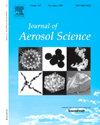具有严格不确定性估计的准确评价污染物扩散的统计超载框架
IF 3.9
3区 环境科学与生态学
Q2 ENGINEERING, CHEMICAL
引用次数: 0
摘要
气溶胶和污染物湍流扩散的准确表征是一个涉及各种室内和室外环境中的湍流的主题。对于通风的室内空间,由于湍流传输和空间不均匀性等因素,扩散过程的随机性导致了变化。统计超载是一种新的技术,其中计算域被大量的污染物粒子过载,这些污染物粒子在空间和时间上随机播种。这将使我们能够捕获大量感兴趣的数据,例如污染物浓度的平均值和变化,对于所有可能的污染物释放和传感位置,只需使用一个主模拟,即可达到所需的精度。在本研究中,统计超载框架被用于在通风室内空间湍流扩散的情况下,使用欧拉-拉格朗日LES模拟在一个维度为10×10×3.2m3的规范房间。我们建立了明确的指导方针,以选择涉及设计湍流扩散模拟的计算参数,并具有潜在的应用于涉及气溶胶,颗粒或污染物扩散的其他挑战。这些参数包括,但不限于,在模拟过程中要跟踪的最小粒子数,以及实现收敛统计到任何指定精度水平所需的最小湍流/空间实现数。我们利用从欧拉-拉格朗日模拟中获得的广泛的拉格朗日统计数据,结合完善的统计理论,得出上述指导方针和要求。本文章由计算机程序翻译,如有差异,请以英文原文为准。
The statistical overloading framework for accurate evaluation of pollutant dispersal with rigorous uncertainty estimation
Accurate characterization of turbulent dispersal of aerosols and pollutants is a topic of interest involving turbulent flows in a variety of indoor and outdoor settings. For the case of a ventilated indoor space, the stochastic nature of the dispersal process results in variations due to factors such as turbulent transport and spatial inhomogeneity. Statistical overloading is a novel technique wherein the computational domain is overloaded with an abundance of pollutant particles that are randomly seeded over space and time. This would allow us to capture quantities of interest, such as mean and variation of pollutant concentration, to any desired accuracy for all possible pollutant release and sensing locations, using just one master simulation. In this study, the statistical overloading framework is employed for the case of turbulent dispersal in ventilated indoor spaces using Euler–Lagrange LES simulations in a canonical room of dimensions . We establish clear guidelines for selecting computational parameters involved in designing turbulent dispersal simulations, with potential applications to other challenges involving aerosol, particulate, or pollutant dispersal. These parameters include, but are not limited to, the minimum number of particles to be tracked during the simulation and the minimum number of turbulent/spatial realizations required to achieve converged statistics to any specified level of accuracy. We leverage the extensive Lagrangian statistics obtained from Euler–Lagrange simulations, combined with well-established statistical theory, to derive the aforementioned guidelines and requirements.
求助全文
通过发布文献求助,成功后即可免费获取论文全文。
去求助
来源期刊

Journal of Aerosol Science
环境科学-工程:化工
CiteScore
8.80
自引率
8.90%
发文量
127
审稿时长
35 days
期刊介绍:
Founded in 1970, the Journal of Aerosol Science considers itself the prime vehicle for the publication of original work as well as reviews related to fundamental and applied aerosol research, as well as aerosol instrumentation. Its content is directed at scientists working in engineering disciplines, as well as physics, chemistry, and environmental sciences.
The editors welcome submissions of papers describing recent experimental, numerical, and theoretical research related to the following topics:
1. Fundamental Aerosol Science.
2. Applied Aerosol Science.
3. Instrumentation & Measurement Methods.
 求助内容:
求助内容: 应助结果提醒方式:
应助结果提醒方式:


